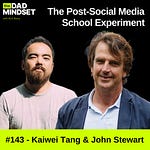John Stewart, the visionary behind the Living School, shares his approach to redefining education and creating a school that fosters critical thinking, collaboration, and a sense of responsibility among students.
The Living School's unique structure includes shorter terms, keystone themes, and three campuses which build in rites of passage.
John emphasises the importance of trust, freedom, and agency in education, as well as embracing failure and leaning into passion. He encourages educators to integrate learning, break down subject barriers, and bring in experts for project-based learning.
“The greatest problem we’ve got for the future is apathy” - John Stewart
John also discusses the challenges and resilience involved in starting a new school and offers advice for parents and educators.
Takeaways
The Living School aims to redefine education by fostering critical thinking, collaboration, and a sense of responsibility among students.
The school's unique structure includes shorter terms to avoid burnout, keystone themes, and three campuses with rites of passage.
Trust, freedom, and agency are essential in education, as well as embracing failure and leaning into passion.
Integrating learning, breaking down subject barriers, and bringing in experts for project-based learning can really enhance the educational experience.
Click here if you’d like to find out more about The Living School.
You can also find The Living School on Instagram here.
Chapters
00:00 Introduction to Living School and Collaboration
03:11 The Vision and Structure of Living School
04:37 The Keystone Themes and Term Structure
06:06 The Three Campuses and Rites of Passage
08:31 The Purpose of Schooling and Community Engagement
09:58 Takeaways from Living School's Approach
13:51 Student Success Stories and Growth
15:43 Comparison of Traditional Systems and Living School
18:30 Teaching Freedom, Agency, and Trust
20:28 Embracing Failure and Growth Mindset
25:20 Creating Connections and Integrating Learning
26:46 Breaking Down Subject Barriers
28:43 Bringing in Experts and Project-Based Learning
31:34 Challenges and Resilience
38:48 Advice for Parents and Educators
Spriggy Cards
One of the things that’s worked really well for us (especially when travelling) is that the kids each have pre-paid Spriggy debit cards to keep their pocket money on.
Setting up an account in Australia usually costs $30 but use this link to receive $20 back when you first sign up (we also get a kickback to help fund the podcast).
Instead of your kids borrowing your debit or credit card to pay for things, especially when buying things online or as cash is something that’s hardly used now, try Spriggy.
You can link directly to your bank account and even give grandparents access in case they want to give money to your kids as well.













